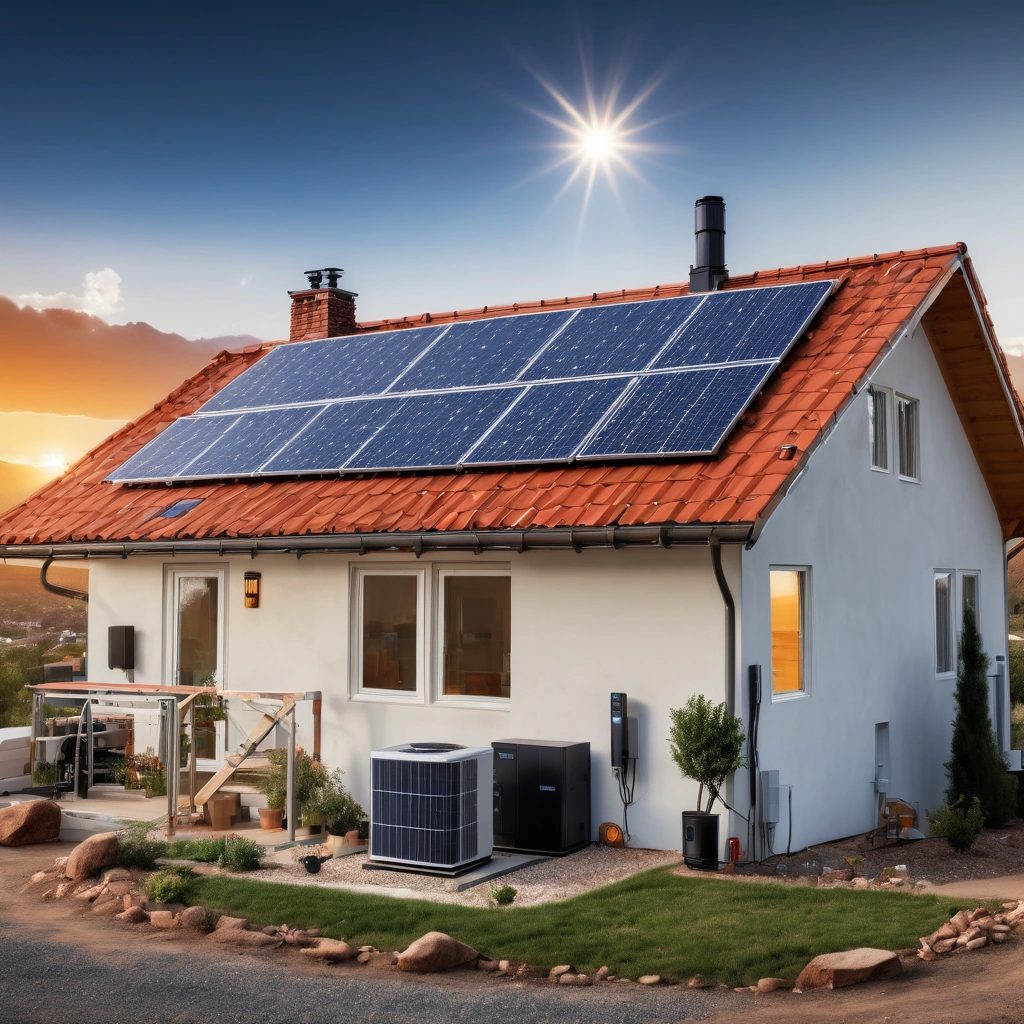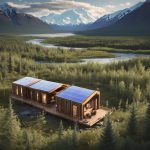Smart Living Off-Grid: Evaluating Home Automation for Energy Efficiency
The Rise of the Smart Off-Grid Home
The allure of off-grid living, once a niche pursuit, is rapidly gaining traction. Fueled by a desire for self-sufficiency, environmental consciousness, and freedom from conventional utility grids, more individuals and families are seeking refuge in remote properties. But disconnecting from the grid doesn’t mean abandoning the comforts and conveniences of modern life. Home automation, powered by renewable energy sources like solar and wind, offers a compelling solution. However, selecting the right off-grid home automation system requires careful evaluation and a deep understanding of energy consumption, system integration, and long-term maintenance.
This article delves into the intricacies of off-grid home automation, providing data-driven insights and practical guidance for maximizing energy efficiency and ensuring system reliability in remote environments. This burgeoning interest in off-grid living is further propelled by advancements in renewable energy technology and the decreasing costs of solar panels, wind turbines, and battery storage systems. According to a report by the Rocky Mountain Institute, the levelized cost of energy (LCOE) for solar and wind has fallen dramatically over the past decade, making these sources increasingly competitive with traditional fossil fuels, even without considering the environmental benefits.
This economic shift, coupled with smart home technology designed for minimal energy draw, empowers off-grid homeowners to create comfortable and efficient living spaces while minimizing their environmental footprint. The convergence of these trends is reshaping the landscape of remote living, making sustainable self-sufficiency more attainable than ever before. One notable example of this trend is the growing popularity of “net-zero” homes in remote areas. These homes, often powered by a combination of solar and battery storage, are designed to produce as much energy as they consume annually.
Smart home technology plays a crucial role in achieving net-zero status by optimizing energy usage through automated lighting, heating, and cooling systems. For instance, smart thermostats like Nest or Ecobee can learn occupancy patterns and adjust temperature settings accordingly, reducing energy waste. Similarly, smart irrigation systems can monitor soil moisture levels and weather forecasts to optimize water usage, conserving both energy and water resources, vital for sustainable off-grid living. These technologies, when carefully selected and integrated, contribute significantly to reducing reliance on backup generators and extending battery life.
However, the transition to smart off-grid living also presents unique challenges. Unlike grid-tied homes, off-grid systems must be meticulously designed to match energy production with consumption. Over-reliance on energy-intensive smart home features can quickly deplete battery reserves, leading to system instability and potential power outages. Therefore, a thorough energy audit is essential before implementing any automation system. This audit should identify areas of high energy consumption and prioritize energy-efficient alternatives. Furthermore, off-grid homeowners must develop a deep understanding of their energy usage patterns and be prepared to adapt their lifestyles to conserve energy during periods of low solar or wind generation. This proactive approach is critical for ensuring the long-term reliability and sustainability of off-grid home automation systems.
Smart Technologies for Remote Properties: Power Consumption Analysis
Several smart home technologies can be adapted for off-grid use, each presenting a unique profile of energy demands that must be carefully analyzed. Lighting, a fundamental aspect of any dwelling, is a prime candidate for automation in off-grid scenarios. The shift to LED bulbs is non-negotiable, offering a dramatic reduction in energy consumption compared to traditional incandescent or even CFL bulbs. Smart lighting systems, such as Philips Hue or Lutron Caseta, while initially conceived for grid-tied homes, can be effectively integrated into off-grid setups due to their inherent energy efficiency.
These systems allow for granular control through dimming and automated scheduling, optimizing energy usage based on occupancy and ambient light levels, thereby minimizing reliance on precious battery reserves. The initial investment in smart lighting is quickly recouped through reduced energy bills and extended battery lifespan, making it a cornerstone of off-grid home automation. HVAC systems, particularly heating and cooling, invariably represent the most significant energy draw in most homes, a challenge amplified in off-grid contexts.
Smart thermostats like Nest or Ecobee offer potential for optimization, but their effectiveness is intrinsically linked to the efficiency of the underlying HVAC equipment. Traditional forced-air systems are often prohibitively energy-intensive for off-grid living. Instead, consider highly efficient mini-split heat pumps, which offer superior performance and can be seamlessly integrated with smart controls for zoned heating and cooling. These systems allow for precise temperature regulation in individual rooms, minimizing energy waste in unoccupied areas. Furthermore, some models offer advanced features like learning algorithms that adapt to user preferences and weather patterns, further optimizing energy consumption.
Smart security systems provide an added layer of safety and peace of mind in remote properties, but their power consumption must be carefully scrutinized. Wireless cameras, door/window sensors, and alarm systems can be integrated to provide comprehensive security coverage. However, it’s crucial to select low-power options and leverage features like motion-activated recording to minimize energy drain. For instance, consider cameras that utilize passive infrared (PIR) sensors to trigger recording only when motion is detected, rather than constantly streaming video.
Smart appliances, such as refrigerators, washing machines, and dishwashers, can also contribute to energy savings. Prioritize Energy Star-rated appliances, as they are designed to minimize energy consumption without compromising performance. Certain models offer smart features like load monitoring, remote control, and optimized washing cycles, allowing homeowners to further fine-tune energy usage. Robotic vacuum cleaners, exemplified by models from iRobot or those employing LiDAR navigation, provide automated cleaning solutions that reduce manual effort. These devices contribute to overall energy conservation by minimizing the need for extensive, power-consuming cleaning sessions.
However, their charging cycles must be factored into the overall energy budget. Schedule cleaning during peak solar production hours to maximize the use of renewable energy and minimize reliance on battery storage. Furthermore, consider models with energy-efficient charging systems and features like automatic return to base when the battery is low. By carefully selecting and managing smart appliances and cleaning devices, off-grid homeowners can maintain a comfortable and convenient lifestyle without compromising their commitment to energy efficiency and sustainability.
Smart irrigation systems offer another avenue for optimizing resource use. These systems utilize soil moisture sensors and weather data to automatically adjust watering schedules, minimizing water waste and conserving energy associated with pumping water from wells or storage tanks. Beyond individual devices, a comprehensive energy monitoring system is essential for effective off-grid home automation. Systems like Sense or Emporia Vue provide real-time insights into energy consumption patterns, allowing homeowners to identify energy hogs and optimize usage accordingly. These systems can track energy production from solar panels or wind turbines, battery storage levels, and the energy consumption of individual appliances, providing a holistic view of the home’s energy ecosystem. Armed with this information, homeowners can make informed decisions about energy usage, prioritize essential loads, and ensure the long-term sustainability of their off-grid lifestyle. This data-driven approach is crucial for maximizing energy efficiency and achieving true self-sufficiency.
Seamless Integration with Solar, Wind, and Battery Storage
The heart of any off-grid home automation system is its seamless integration with renewable energy sources. Solar power remains the most common and accessible choice, but wind power, micro-hydro, and hybrid systems offer compelling alternatives or supplements, especially in regions with consistent wind or water resources. Proper system sizing is paramount for achieving energy independence. Utilizing online solar calculators is a good starting point, but consulting with certified solar professionals or renewable energy integrators is crucial for accurate load calculations and determining the appropriate number of solar panels, wind turbine capacity, and battery storage capacity.
This ensures the system can reliably meet the demands of the smart home technology, even during periods of low sunlight or wind. Battery technology is also a key consideration influencing the overall energy efficiency and lifespan of the off-grid home automation setup. Lithium-ion batteries, including Lithium Iron Phosphate (LiFePO4) variants, are gaining traction due to their high energy density, extended lifespan, and improved safety compared to older lead-acid technologies. While lead-acid batteries offer a more budget-friendly initial investment, their shorter lifespan and lower depth of discharge often result in higher long-term costs and more frequent replacements.
Charge controllers are essential components that regulate the flow of electricity from the renewable energy source to the batteries, preventing overcharging and maximizing battery lifespan. Advanced charge controllers also incorporate Maximum Power Point Tracking (MPPT) technology, which optimizes energy harvesting from solar panels by continuously adjusting the voltage and current to the point of maximum power output. Inverters play a critical role in converting the DC electricity stored in batteries into AC electricity suitable for powering standard household appliances and smart home devices.
Selecting an inverter with high efficiency is crucial to minimize energy losses during the conversion process, maximizing the usable power from the battery bank. Look for inverters with a Total Harmonic Distortion (THD) rating of less than 5% to ensure clean and stable AC power for sensitive electronic equipment. Smart energy management systems, such as those offered by companies like Schneider Electric and Generac, provide advanced control and monitoring capabilities for off-grid home automation. These systems can automate load shedding, prioritize critical loads during periods of low energy production, and integrate with weather forecasts to anticipate energy needs and adjust system settings accordingly. As noted by Sarah Jones, a leading renewable energy consultant, “The key to successful off-grid living is not just generating enough power, but managing it intelligently. Smart home technology, coupled with sophisticated energy management systems, allows homeowners to optimize energy consumption and maximize self-sufficiency.”
Maintenance, Troubleshooting, and Long-Term Cost Considerations
Maintaining an off-grid home automation system requires a proactive approach, blending traditional maintenance with the nuances of smart home technology. Regularly inspect solar panels for dirt and debris, as even a thin layer can significantly reduce solar power generation, impacting battery storage capacity and overall energy efficiency. Check battery terminals for corrosion, a common issue in remote properties, and ensure proper ventilation to prevent the buildup of explosive gases. Monitor battery voltage and state of charge meticulously; invest in a quality battery monitor that provides real-time data and alerts to identify potential problems early on, preventing costly replacements.
Periodically test backup generators and other emergency power sources to guarantee seamless transitions during periods of low renewable energy production. For wind power systems, inspect turbine blades for damage and ensure proper lubrication of moving parts. For troubleshooting off-grid home automation systems, start with the basics: check fuses, breakers, and wiring connections. A surprising number of issues stem from loose connections or blown fuses. Consult the system’s documentation for troubleshooting guides, but remember that these guides often assume a grid-tied system.
Invest in a quality multimeter and learn how to use it to diagnose electrical problems safely. When issues arise, systematically isolate the problem by disconnecting components one at a time. For example, if a smart lighting system is malfunctioning, disconnect it from the network to see if the issue persists. Remember to document every step of the troubleshooting process; this log will be invaluable for future reference and for assisting any technicians you may need to call.
Understanding the interplay between your renewable energy sources, battery storage, and smart home technology is crucial for effective troubleshooting. Long-term cost considerations are paramount for sustainable living in remote properties. Factor in the replacement cost of batteries, which typically need to be replaced every 5-10 years, depending on the type and usage patterns. Lithium-ion batteries offer longer lifespans but come with a higher upfront cost. Consider the cost of preventative maintenance and repairs, including professional inspections of solar panels and wind turbines.
Explore options for remote monitoring and control, which can help identify problems before they escalate, potentially saving thousands of dollars in repairs. Many smart home technology systems offer remote access, allowing you to monitor energy consumption and system performance from anywhere. Building a relationship with a local electrician or renewable energy specialist who is familiar with off-grid systems is invaluable; their expertise can save you time and money in the long run. Furthermore, consider the long-term impact of software updates on your off-grid home automation system.
Many smart home devices rely on cloud-based services, which can become obsolete or unsupported over time. Choose devices that offer local control options and prioritize open-source platforms that are less reliant on proprietary software. Regularly back up your system configurations to prevent data loss in case of hardware failure. Explore energy efficiency upgrades beyond basic smart home technology; consider investing in high-efficiency appliances and insulation to reduce your overall energy consumption, minimizing the strain on your renewable energy system. By proactively addressing maintenance, troubleshooting, and long-term cost considerations, you can ensure the longevity and reliability of your off-grid home automation system, maximizing its contribution to a sustainable and self-sufficient lifestyle.
Embracing Sustainable Self-Sufficiency
Off-grid home automation represents more than just technological integration; it embodies a profound shift towards sustainable living and self-sufficiency. By meticulously curating energy-efficient technologies and seamlessly integrating them with renewable energy sources like solar power and wind power, homeowners can achieve a harmonious balance between modern comforts and environmental responsibility. A proactive maintenance plan is not merely an afterthought but a cornerstone of this lifestyle, ensuring the longevity and optimal performance of the entire system.
This holistic approach allows individuals to minimize their environmental footprint while enjoying the benefits of smart home technology, even in remote properties. The journey to a smart off-grid home demands careful planning and continuous learning, but the rewards extend far beyond mere energy independence. Reduced environmental impact translates to a tangible contribution to a healthier planet, while increased resilience provides a buffer against the uncertainties of a rapidly changing world. Consider, for example, a family in rural Colorado using off-grid home automation to manage their solar power and battery storage.
Through smart thermostats and automated lighting, they optimize energy consumption, reducing their reliance on a backup generator and minimizing their carbon footprint. This proactive approach not only saves them money but also empowers them to live in greater harmony with nature. As technology continues its relentless march forward, we can anticipate even more innovative and efficient solutions to emerge, further democratizing access to off-grid living. Expect advancements in battery storage technology to significantly increase energy density and lifespan, making renewable energy sources even more reliable.
Furthermore, the integration of artificial intelligence and machine learning will enable smarter energy management, optimizing consumption patterns based on real-time data and predictive analytics. The convergence of these trends promises a future where off-grid living is not just a viable option but a compelling choice for those seeking a more sustainable and self-sufficient existence. The future of sustainable living hinges on embracing smart home technology and renewable energy, making off-grid home automation a crucial element in building a more resilient and environmentally conscious world.


